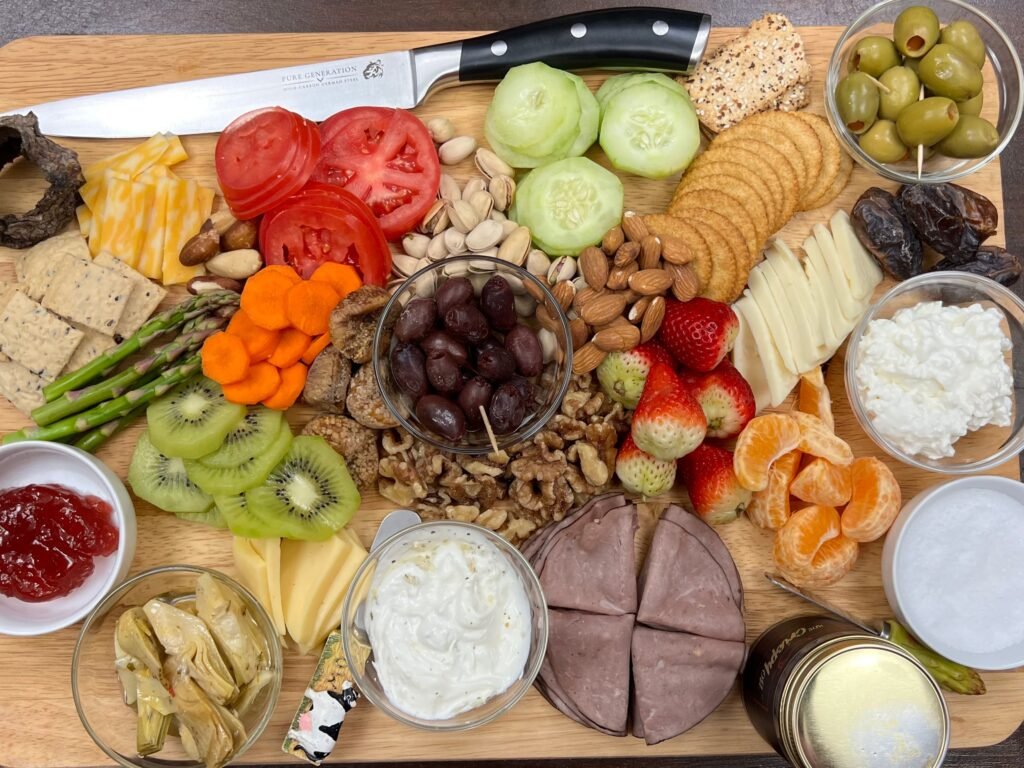No products in the cart.
Charcuterie Board
Welcome to the wonderful world of charcuterie boards, where art meets gastronomy. These visually stunning creations are no longer limited to fancy cheese shops or high-end restaurants, but have found their way into homes and gatherings everywhere.
A charcuterie board is a sophisticated display of cured meats, fine cheeses, artisanal breads, and a variety of condiments and accompaniments. It’s a feast for the eyes and the taste buds, perfect for entertaining guests or simply indulging in a decadent evening at home.
With endless possibilities for creativity, you can tailor your charcuterie board to suit your personal preferences and dietary restrictions. Whether you prefer classic flavors or experimental pairings, there’s a charcuterie board that will satisfy your cravings and impress your guests.
Get ready to embark on a culinary adventure as we delve into the world of charcuterie boards. Discover expert tips on selecting the perfect ingredients, arranging a visually appealing display, and creating flavor combinations that will leave your taste buds wanting more. Join us as we elevate your entertaining game and transform your gatherings into unforgettable experiences with the art of the charcuterie board.
What is a charcuterie board?
A charcuterie board is a carefully curated selection of cured meats, cheeses, breads, fruits, nuts, and condiments arranged on a platter or wooden board. Originating from France, charcuterie refers to the art of preparing and preserving meats, typically through techniques like smoking, salting, and curing. The term has expanded to include a wider range of cured and preserved foods.
The beauty of a charcuterie board lies in its versatility. You can customize it to suit any occasion, whether it’s an intimate gathering with friends, a formal dinner party, or a cozy night in with loved ones. The board serves as a centerpiece that not only satisfies hunger but also stimulates conversation and creates a memorable experience.
History of charcuterie boards
The tradition of charcuterie dates back centuries, originating in France as a way to preserve meat before the advent of refrigeration. Charcutiers, skilled craftsmen in the art of curing and preserving meats, would create an assortment of delicacies such as sausages, pâtés, terrines, and rillettes. These preserved meats were enjoyed on their own or as part of a larger meal.
Over time, charcuterie evolved from a necessity to an art form. The emphasis shifted from purely preserving meats to creating flavor profiles that delighted the senses. The practice of arranging cured meats, cheeses, and other accompaniments on a board became popular in European culinary traditions, and eventually made its way across the globe.
Benefits of serving a charcuterie board
Serving a charcuterie board offers a multitude of benefits for both the host and the guests. Firstly, it provides a visually appealing display that adds a touch of elegance to any gathering. The vibrant colors of the meats, cheeses, and garnishes create a feast for the eyes, enticing guests to indulge in the array of flavors.
Additionally, a charcuterie board offers a wide variety of options to cater to different dietary preferences and restrictions. Whether your guests follow a gluten-free, vegetarian, or keto diet, there are plenty of choices to ensure everyone finds something they can enjoy. From artisanal cheeses to plant-based alternatives, the board can be customized to accommodate various tastes and needs.
Furthermore, a charcuterie board encourages social interaction and conversation. Guests can gather around the board, explore different flavors, and discuss their favorites. It becomes a focal point that brings people together, fostering a sense of community and enjoyment.
Choosing the right ingredients for your charcuterie board
When it comes to selecting the perfect ingredients for your charcuterie board, variety is key. Aim for a balance of flavors, textures, and colors to create an exciting and visually appealing spread. Here are some essential components to consider:
- Cured Meats: Choose a selection of cured meats such as prosciutto, salami, coppa, and chorizo. Opt for a mix of flavors and textures to create a well-rounded experience. Thinly sliced meats are easier to handle and allow guests to sample a variety without overwhelming their palate.
- Cheeses: Include a range of cheeses with different textures and flavors. Consider a mix of soft, semi-soft, and hard cheeses. Some popular options include Brie, Camembert, Gouda, Cheddar, and Blue cheese. Don’t be afraid to experiment with unique cheese varieties to add a touch of intrigue to your board.
- Breads and Crackers: Offer a selection of artisanal breads, breadsticks, and crackers to complement the meats and cheeses. Choose options with different textures and flavors, such as baguette slices, sourdough, rye, or gluten-free alternatives.
- Fruits and Nuts: Add a touch of freshness and natural sweetness with a variety of fruits. Grapes, figs, berries, and sliced apples or pears work well. Nuts like almonds, walnuts, and pistachios provide a satisfying crunch and pair nicely with the other components.
- Condiments and Spreads: Enhance the flavors of your charcuterie board with a range of condiments and spreads. Include items like honey, mustard, chutney, olives, pickles, and jams. These add a delightful contrast of flavors and textures.
Remember to consider your guests’ dietary restrictions and preferences when selecting ingredients. Label any allergens or specific dietary information to ensure everyone can enjoy the board safely.
Stay tuned for the next section on arranging and styling your charcuterie board, where we’ll explore techniques to create an appealing and visually stunning display. Get ready to take your entertaining game to the next level!

